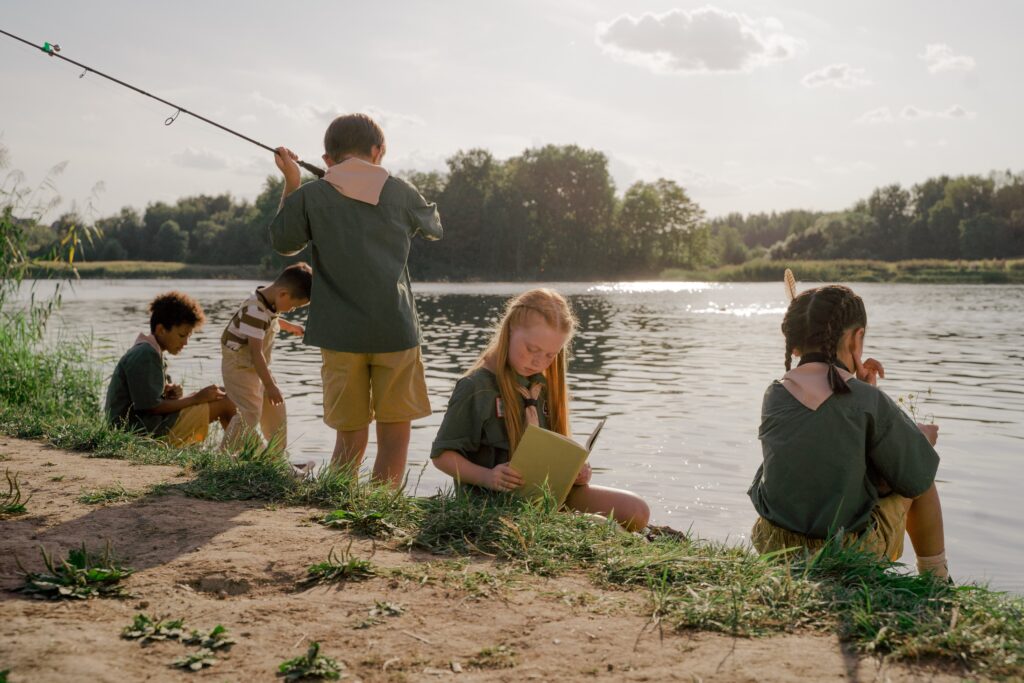As a kid, your first leap into the world of fishing can be intimidating and overwhelming. For me, it was the same way. The terminology and various types of equipment pile up quickly. When I first started fishing, I watched countless videos and read many articles to try and learn as much as possible. However, my learning curve was much longer than it should have been. I quickly realized that most fishing information available assumes that you have some level of base knowledge. I wish I could have learned from a young fisherman like myself who better understood what it felt like to first start learning about fishing.
My goal for this article is to educate the youth fisherman out there on everything that I have learned throughout my journey from one young angler to another.
Table of Contents:
- Types of Rods and Reels
- Types of Fishing Line
- Types of Fishing Hooks
- Best Lures For Kids
- Seasonal Fish Migrations
- Where To Fish
- Water Safety
- Fishing License Information
- Conservation
Types of Rods and Reels
The two main types of fishing rods and reels are called spinning and casting. The two main differences between spinning and baitcasting setups is the spool orientation and the reel location. We’ll dive deeper into the differences between them below.

Spinning
The first type of fishing rod and reel that we will talk about is the spinning rod and reel. The spinning reel spool faces forwards, towards the tip of your rod. The fishing line comes off of the spool perpendicular. The spinning reel and guides sit on the underside of the rod.
Spinning reels are generally better for casting very lightweight lures (under 1/4 ounce). Additionally, spinning reels are much easier to cast for beginners compared to casting reels. If you don’t have any experience fishing, I’d recommend getting started with a spinning rod and reel.
Casting/Baitcasting
The other type of fishing rod and reel is called the casting rod and reel. The casting reel spool is perpendicular to the rod, allowing the line to come straight off the spool and through the guides. The casting reel and guides sit on the top side of the rod.
Casting reels are known to be more difficult to use for beginners. When I first started fishing, I began with a spinning setup and eventually worked my way up to a casting setup. I watched videos to learn how to cast a baitcaster and practiced as much as possible. I failed a lot with the casting setup before getting comfortable with it. Once you reach this point, you’ll learn that casting reels allow you to fish heavier lures (over 1/4 ounce) with much more casting control.
Types of Fishing Line
The three main types of fishing line are called fluorocarbon, monofilament, and braid. I’ll do my best to simplify the differences between these lines and their applications since this is often a source of confusion for young fisherman.
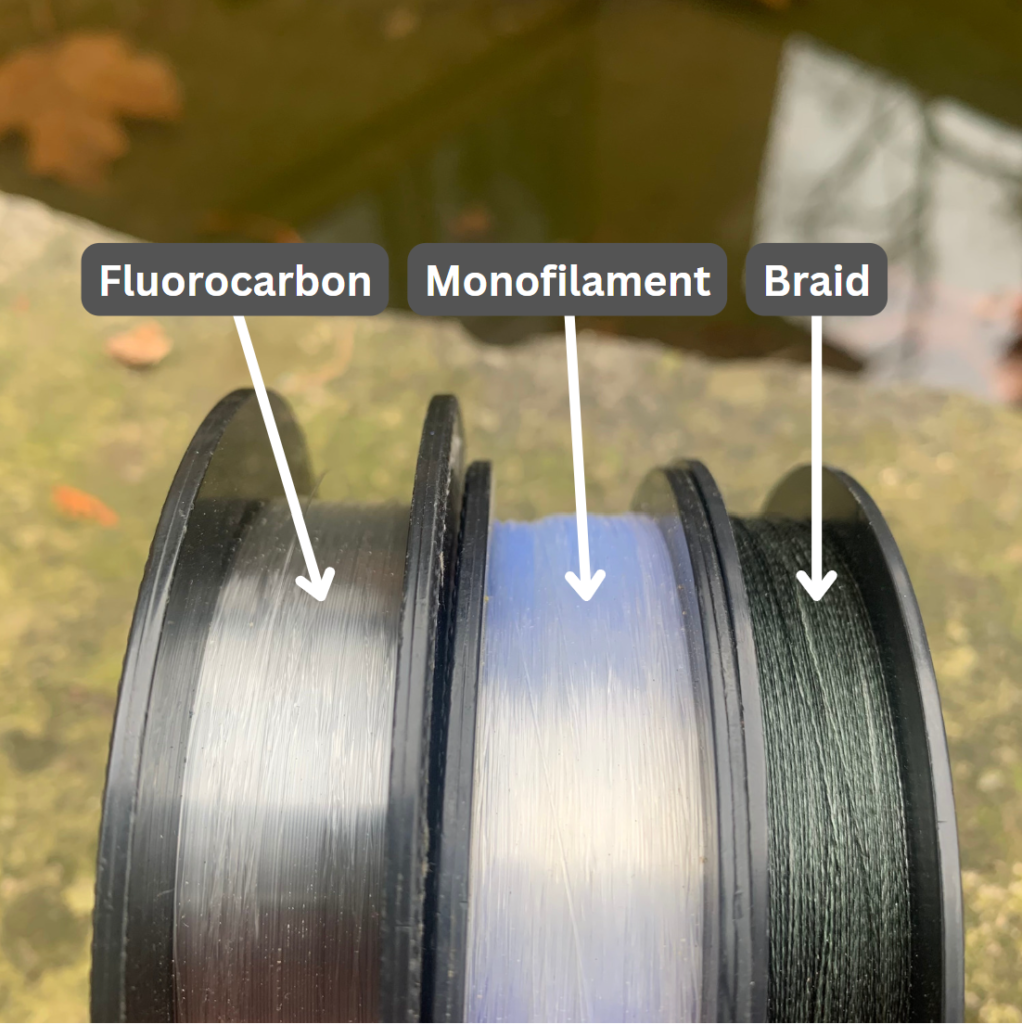
Fluorocarbon
Fluorocarbon is a smooth type of fishing line that is translucent in color. The benefit to fluorocarbon is that it is practically invisible underneath the water. If you are fishing very clear water, fluorocarbon is a good choice to prevent fish from seeing your fishing line.
Monofilament
Monofilament looks very similar to fluorocarbon, but is not as invisible underneath the water. Additionally, monofilament has more stretch than fluorocarbon. This added stretch is beneficial when fishing with treble hooks or Aberdeen hooks, but not as good for hooks with thicker wire.
Braid
Braid looks completely different than the other types of fishing lines we previously talked about. It is not at all translucent in color, but instead usually comes in a variety of colors such as green, yellow, or blue. Braided fishing line does not have any stretch which makes it very sensitive at detecting bites. Additionally, having no stretch is important when fishing heavy wire hooks. As mentioned earilier, braid is not translucent in the water. When fishing clear water, you’ll want to tie a section of fluorocarbon or monofilament line onto the end of your braided line to prevent fish from seeing the line.
This is where learning how to tie fishing knots is important. The most useful fishing knots that I have learned over the years are the Improved Clinch Knot, Palomar knot, and Albright knot.
Types of Fishing Hooks
There’s lots of different styles of fishing hooks and each is used for a different application. We will cover the terminology used for hooks as well as three common types of fishing hook styles that you may encounter.
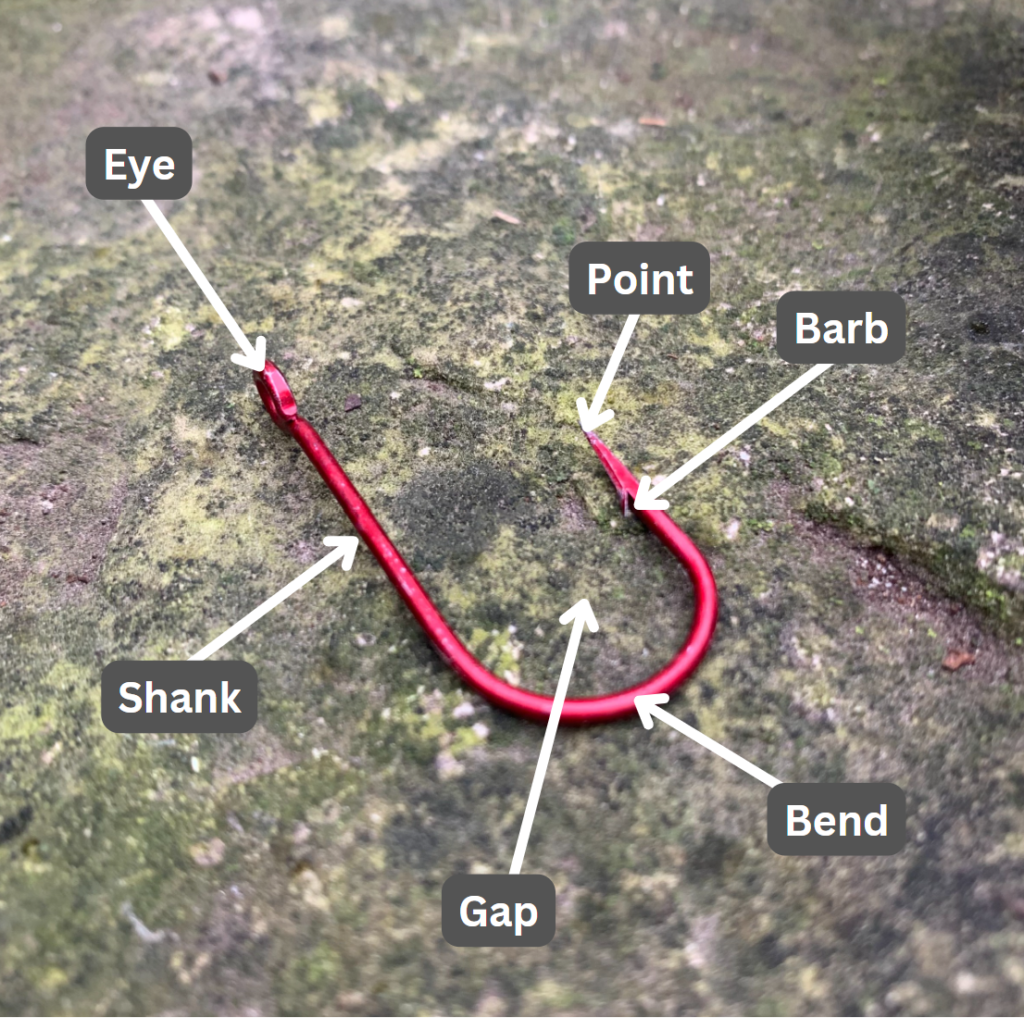
Circle
The circle hooks gets its name from its circular shape. The shape of this hook prevents fish from getting gut hooked if they swallow the bait before you feel the bite. For this reason, circle hooks are often used when fishing with live bait.
Aberdeen
Aberdeen hooks are very thin and have a straight shank. They typically come in smaller sizes and are ideal when fishing with live bait for panfish.
Treble
Treble hooks are hooks that have three separate hooks points. You’ll find treble hooks on most crankbaits and other hard-bodied lures.
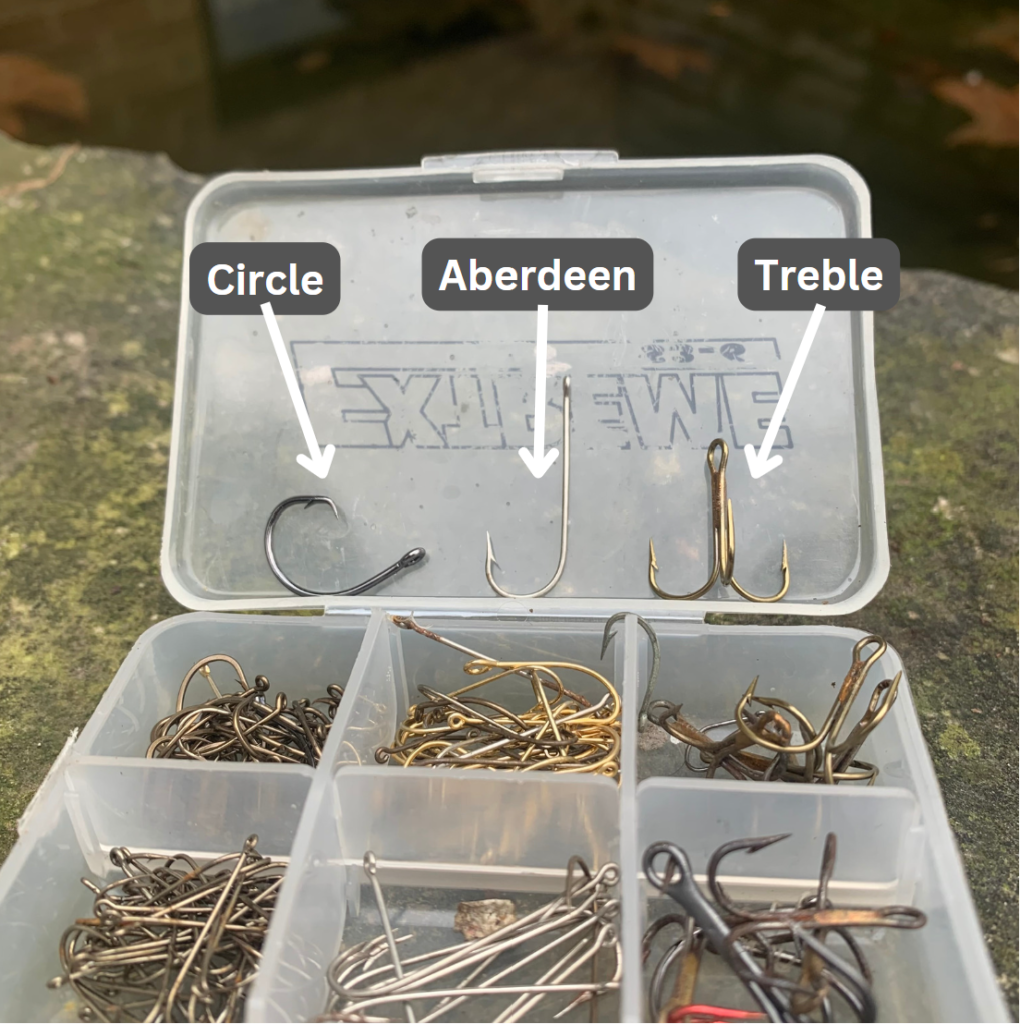
Best Lures For Kids
There are tons of lures available, but here are some of the easiest to use and most versatile lures to use when first getting started.
Jigs
Jigs are one of the most versatile lures when it comes to fishing. The jig refers to a hook with a weighted head. They come in different weights and styles which can be fished at a variety of depths.
You can choose to either tip your jig with a soft plastic lure or live bait. Either hop the jig with your rod tip along the bottom or use a steady retrieve by slowly turning your reel handle. Jigs are my personal favorite choice when fishing for panfish or walleye.
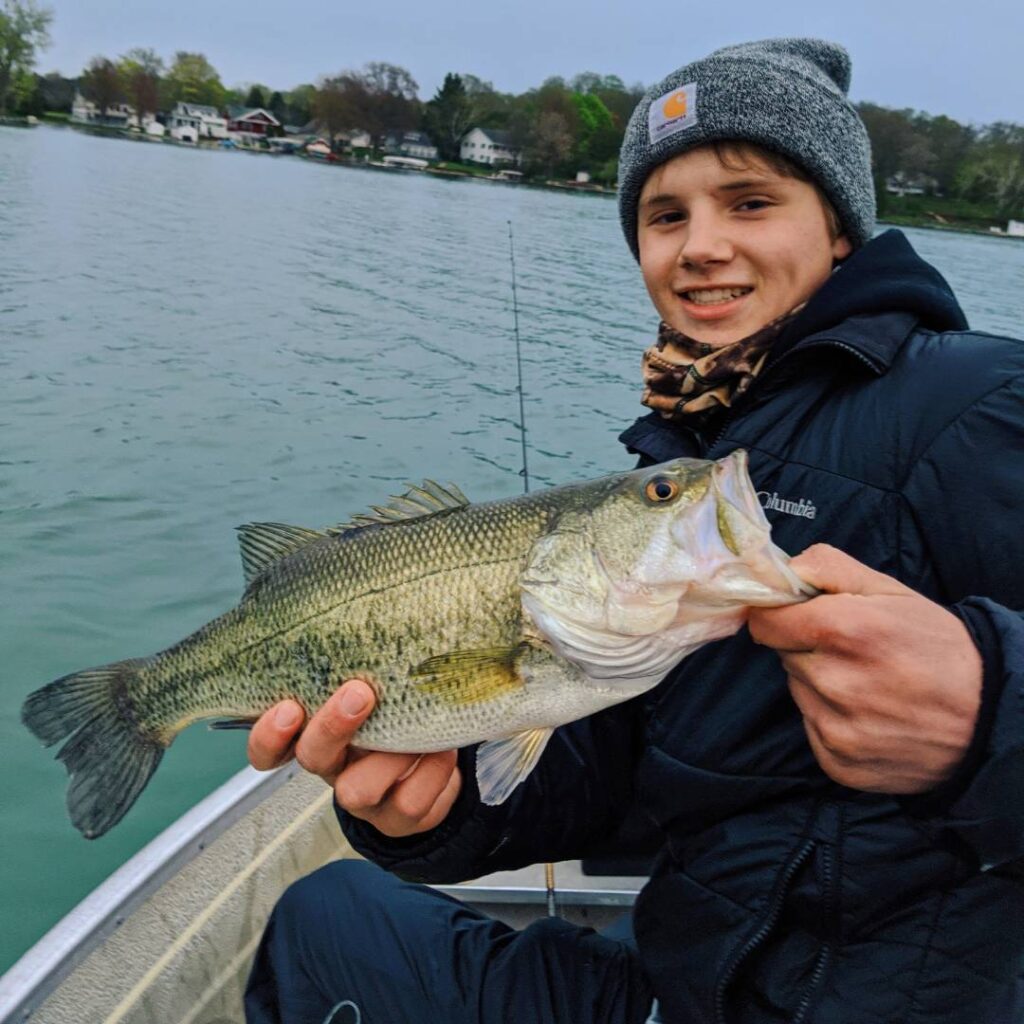
Crankbaits
Crankbaits are another beginner friendly lure that is great when targeting larger fish species such as bass, northern pike, or walleye. Crankbaits have a bill which allows them to dive in the water when reeling in. Be sure to have a set of pliers accessibly when fishing a crankbait since the treble hooks can be difficult and dangerous to remove from the fish. Crankbaits come in a variety of different styles, each with a different diving depth. Be sure to check the descriptions, and choose a crankbait that dives just a bit shallower than the depth of water you will be fishing. For example, if you plan on fishing in 10 feet of water, a crankbait that dives 6-8 feet is a good choice.
Retrieving a crankbait is easy. Simply cast it out and start reeling at a constant speed. You’ll notice that your rod tips starts to vibrate and bounce. When this happens, you are reeling at the correct speed.
Live Bait
I’d be doing you a disservice by not mentioning live bait in this article. This is how I and many other kids get started in fishing. The benefit to using live bait is that you can just let it sit, and the live bait will do the work for you. The main types of live baits used are nightcrawlers, leeches, and minnows. Nightcrawlers and leeches work best in the summer while minnows work best in the winter.
I’d recommend either using a jig or bobber rig for live bait. Use a jig when fishing deep water (over 15 feet) and a bobber for any shallower.
Know The Seasonal Migrations
Fish location is always changing and it’s difficult to know exactly where to find them. However, being aware of the general fish migration patterns can help point you in the right direction.
Spring
In the spring, most fish move shallow to spawn. If you plan on fishing from the shore, this is a great time of the year to do so. Look for shallow flats with weeds in the springtime, and you’ll be well on your way to finding fish.
Summer
When summertime roles around, water temperatures rise. This pushes a lot of fish out to deeper water that has more oxygen. Instead of being next to the shore like they are in the spring, fish are more likely to be on off-shore locations in the summer.
Fall
The water temperatures cool back down in the fall. The uniform water temperatures tend to scatter fish this time of the year. Some fish remain deep while others move back to the shallows.
Ice Fishing
When winter sets in, lakes freeze over and the weeds die off. Without any weeds, fish often relate to basin areas. Basin areas are deep holes that are surrounded by shallower water. Look for basin areas that bottom out at around 15-30 feet of water. This is where I’ve had my best success ice fishing over the years.
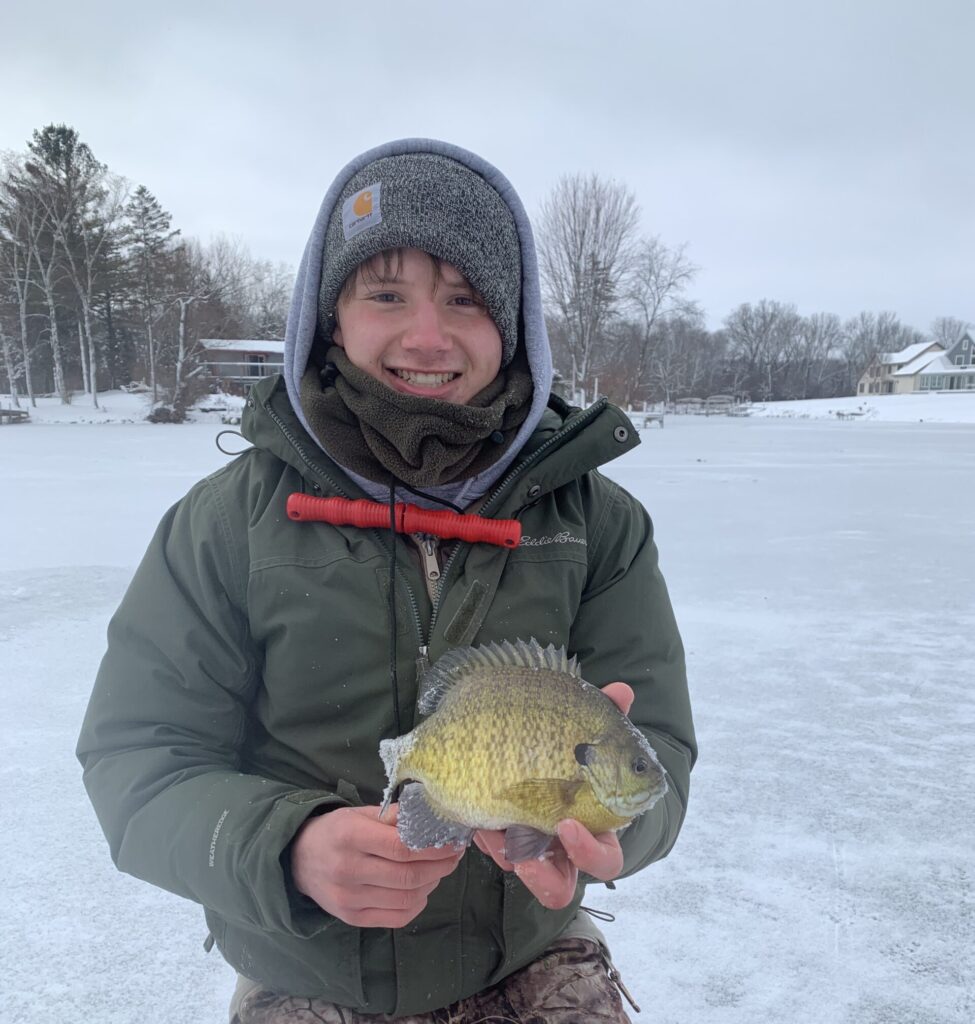
Where to Fish
Vegetation
Vegetation or weeds are fish magnets a lot of the time. They provide cover for smaller fish like minnow and panfish. These smaller fish than attract the larger fish as a result. Focus on fishing weed edges or gaps in the weeds since these are often where fish concentrate.
Submerged Wood
Submerged wood is similar to vegetation, since it provides cover for smaller fish. You’ll find submerged wood such as fallen trees along the shorelines a lot of the time. Focus on these areas when fish are in the shallows, such as in the spring and fall.
Rocks
If you ever hear anybody say “hard bottom”, they are more than likely talking about areas with rocks. Rocks are good areas to target in the summer. Additionally, rocks are known to be good locations when fishing for walleye.
Points
Points are another great location to try the next time you head out fishing. Fish naturally congregate around points throughout all times of the year. The depth that you should target changes however depending on the specific season.
Humps or Islands
Humps and islands are another popular fishing location. These are shallow water locations that are entirely surrounding by deeper water. Fish may be in the shallow water in the morning/evening and in the surrounding deeper water during the mid-day period.
Safety on the Water
I know that safety isn’t the most fun thing to talk about, and I used to feel the same way. However, safety should be your number one priority when fishing. If you are fishing in a boat, always wear your life vest. Tell someone where you plan on fishing and when you expect to be back. If you are fishing at night, always bring a headlamp. These are just a few examples of some of the most important fishing safety tips to keep in mind.
Fishing License
Now that you are well informed on the basic types of fishing gear, let’s talk about one more essential thing you may need.
Depending on your age, you may need to purchase a fishing license. This license will be valid for a year (April 1 – March 31) before you have to repurchase it again. You need a separate fishing license for each state you plan on fishing in as well. Be sure to check your state’s DNR website to locate this information.
Conservation
This article has a lot of information, but the final piece I want to add is the importance of conservation when fishing. When I was younger, it was difficult for me to think well into the future. As fisherman however, it is important for us to realize that our actions will have an impact on the future success of these fisheries. This impact can either be positive or negative. Just because you’re young doesn’t mean you can’t do the right thing and set a good example for others.
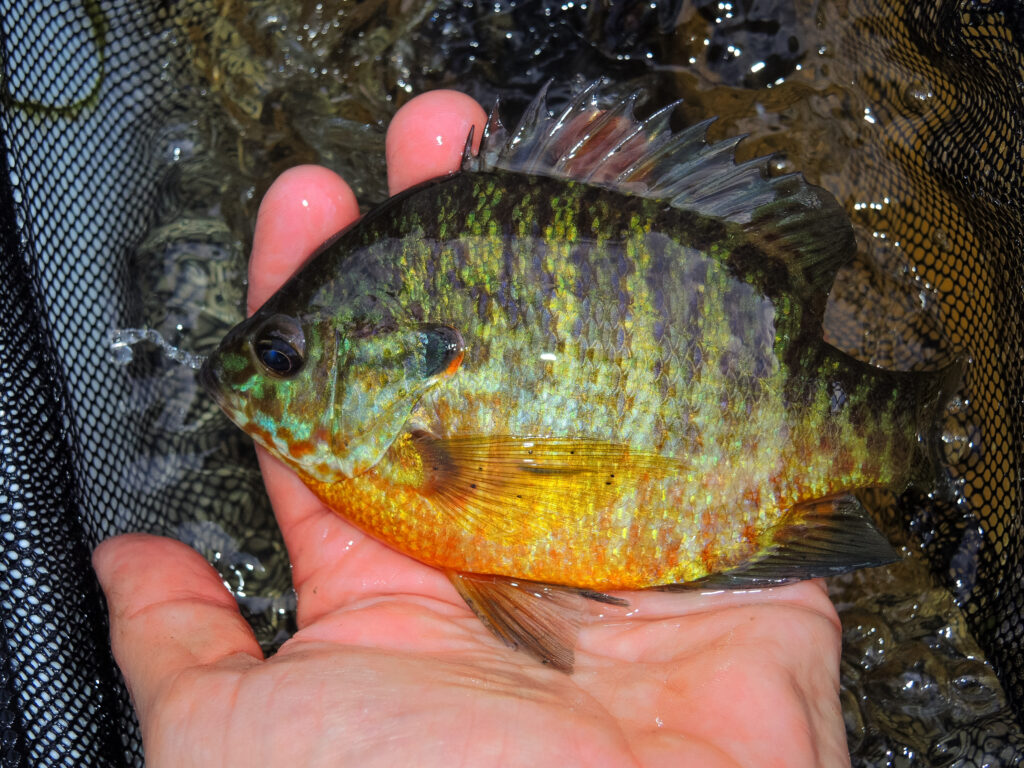
Catch and Release
Adhere to catch-and-release guidelines whenever possible to preserve fish populations for future generations. Handle fish with care, use barbless hooks to minimize injury, and return them to the water as quickly and gently as possible. If you plan on keeping a few fish for a meal, release the larger fish to let them spawn.
Regulations and Limits
Stay informed about local fishing regulations and adhere to size and bag limits. These limits are in place to ensure sustainable fish populations and health
Congratulations! You’ve made it to the end of the ultimate fishing guide for kids. I hope this was helpful in explaining some of the key fishing concepts you need to know before getting started. I was in your shoes not too long ago, and I know it can be intimidating. Don’t hesitate to reread this article until you understand all of the information. The Angler’s Line is all about building a community centered around fishing and conservation, so that we can all enjoy this great resource for years to come. Follow guidelines and practice catch and release fishing to do your part in protecting our natural resources.
More Related Articles:
- The Ultimate Kids Fishing Guide
 As a kid, your first leap into the world of fishing can be intimidating and overwhelming. For me, it was the same way. The terminology and various types of equipment pile up quickly. When I first started fishing, I watched countless videos and read many articles to try and learn as much as possible. However, … Read more
As a kid, your first leap into the world of fishing can be intimidating and overwhelming. For me, it was the same way. The terminology and various types of equipment pile up quickly. When I first started fishing, I watched countless videos and read many articles to try and learn as much as possible. However, … Read more - How to Fizz a Walleye: A Complete Guide for Anglers
 How To Fizz A Walleye: Hey there, fellow anglers! If you’ve ever reeled in a walleye from the deep waters and noticed it looking a bit bloated or struggling to stay upright in the water, they more than likely require fizzing for a successful release. Don’t worry, though – I’ve got your back. In this … Read more
How To Fizz A Walleye: Hey there, fellow anglers! If you’ve ever reeled in a walleye from the deep waters and noticed it looking a bit bloated or struggling to stay upright in the water, they more than likely require fizzing for a successful release. Don’t worry, though – I’ve got your back. In this … Read more - Unleashing the Power of Catch and Release: Secrets to Safely Releasing Fish
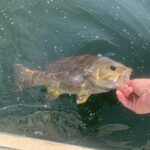 Everyone can enjoy the outdoors and our fisheries by using safe catch and release fishing practices. Catch and release fishing helps create a sustainable ecosystem that can be enjoyed for generations to come. If you are a beginner to fishing, it is important to learn about the proper measured to take to maximize catch and … Read more
Everyone can enjoy the outdoors and our fisheries by using safe catch and release fishing practices. Catch and release fishing helps create a sustainable ecosystem that can be enjoyed for generations to come. If you are a beginner to fishing, it is important to learn about the proper measured to take to maximize catch and … Read more
